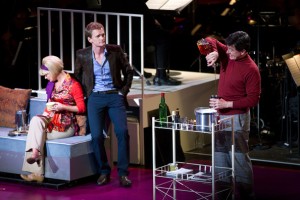Two lyrics struck me as particularly apt in summing up my reactions to the the film adaptation of Into the Woods.
Wishes come true / Not free
Any adaptation is going to involve changes, including cuts. Into the Woods is not at the top of my list of Sondheim’s stuff, so I’m less offended by omissions than would be people who like it more… But can anyone really argue with cutting the farewell song to the cow? Jack still has a really great song later. “Ever After” leads up to a non-existent intermission, so I understand why it needed to go.
The only song I actually missed was “No More,” which normally I don’t appreciate because it’s part of that long, kind of boring stretch of ballads that goes on and on in the second act. But replacing it with the Baker just sitting down and crying breaks one of the rules of the genre: You don’t cry, you sing what you’re crying about. (I realize this technically contradicts what I just said about “I Guess This Is Goodbye,” but we already understand Jack’s attachment. The hug really does tell us enough.) And the cut “No More” is actually symptomatic of the larger problem of rethinking the Narrator/Baker’s father, which is discussed thoroughly here.
A few changes I particularly liked:
- Casting Jack as an actual kid was great (and necessary for a movie). Contrast that to the much weirder effect of casting Tobias as an actual kid in Sweeney Todd. He is a good little singer and held his own in his scenes with Tracey Ullman or James Corden.
- Re-setting Cinderella’s song on the steps of the palace works, too. This movie made me realize how much of the story is told through characters’ songs after the fact. The songs that incorporated visual flashbacks were less effective, and “I Know Things Now” teetered between creepy and dumb.
- “Your Fault” seemed slowed down a little. Maybe this takes away from its effectiveness as a representation of an argument, but I understood lyrics here that I never caught before.
Is it always “or”? / Is it never “and”?
Film adaptations aren’t meant to replace live productions, and there’s already a filmed version of the staged Into the Woods, so I’m fine with the movie being what it is: an almost uniformly strong cast bringing to a wide audience a work that has a pretty fun (but not that deep) first act and a not-that-fun (but attempting to be deep) second act. I’m glad I saw it, but I’d probably watch the video of the original cast before watching the movie again.







